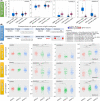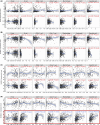Integrative analysis regarding the correlation between GAS2 family genes and human glioma prognosis
- PMID: 33713047
- PMCID: PMC8026934
- DOI: 10.1002/cam4.3829
Integrative analysis regarding the correlation between GAS2 family genes and human glioma prognosis
Abstract
Background: Emerging oncogenes were reportedly linked to the complicated subtypes and pathogenesis of clinical gliomas. Herein, we first comprehensively explored the potential correlation between growth-arrest-specific two family genes (GAS2, GAS2L1, GAS2L2, GAS2L3) and gliomas by bioinformatics analysis and cellular experiments.
Methods: Based on the available datasets of TCGA (The Cancer Genome Atlas), CGGA (Chinese Glioma Genome Atlas), and Oncomine databases, we performed a series of analyses, such as gene expression, survival prognosis, DNA methylation, immune infiltration, and partner enrichment. We also utilized two glioma cell lines to conduct the colony formation and wound-healing assay.
Results: GAS2L3 gene was highly expressed in glioma tissues compared to normal brain tissues (p < 0.05). We further observed the relationship between the high expressed GAS2L3 and poor clinical prognosis of brain low-grade glioma (LGG) cases in our Cox proportional hazard model (hazard ratio [HR] = 0.1715, p < 0.001). Moreover, DNA hypomethylation status of GAS2L3 was correlated with the high expression of GAS2L3 in LGG tissues and the poor clinical prognosis of primary glioma cases (p < 0.05). We also found that the high expression of GAS2L3 was associated with the infiltration level of immune cells, especially the T cells (p < 0.0001). Functional enrichment analysis of GAS2L3-correlated genes and interaction partners further indicated that GAS2L3 might take part in the occurrence of glioma by influencing a series of biological behaviors, such as cell division, cytoskeleton binding, and cell adhesion. Additionally, our cellular experiment data suggested that a highly expressed GAS2L3 gene contributes to the enhanced proliferation and migration of glioma cells.
Conclusion: This study first analyzed the potential role of GAS2 family genes, especially GAS2L3, in the clinical prognosis and possible functional mechanisms of glioma, which gives a novel insight into the relationship between GAS2L3 and LGG.
Keywords: GAS2; GAS2L1; GAS2L2; GAS2L3; glioma.
© 2021 The Authors. Cancer Medicine published by John Wiley & Sons Ltd.
Conflict of interest statement
The authors declare no competing financial interests.
Figures







Similar articles
-
Identification of DNA methylation-regulated WEE1 with potential implications in prognosis and immunotherapy for low-grade glioma.Cancer Biomark. 2024;40(3-4):297-317. doi: 10.3233/CBM-230517. Cancer Biomark. 2024. PMID: 39213054 Free PMC article.
-
The prognostic model of low-grade glioma based on m6A-associated immune genes and functional study of FBXO4 in the tumor microenvironment.PeerJ. 2025 Mar 21;13:e19194. doi: 10.7717/peerj.19194. eCollection 2025. PeerJ. 2025. PMID: 40130175 Free PMC article.
-
Bioinformatics insights into ACSL1 and ACSL5: prognostic and immune roles in low-grade glioma.BMC Cancer. 2025 Feb 10;25(1):226. doi: 10.1186/s12885-025-13651-w. BMC Cancer. 2025. PMID: 39924494 Free PMC article.
-
Growth arrest-specific 2 protein family: Structure and function.Cell Prolif. 2021 Jan;54(1):e12934. doi: 10.1111/cpr.12934. Epub 2020 Oct 25. Cell Prolif. 2021. PMID: 33103301 Free PMC article. Review.
-
Insights into Structure and Function of Growth Arrest Specific 2 (GAS2).J Cancer. 2025 Jan 1;16(1):146-156. doi: 10.7150/jca.102893. eCollection 2025. J Cancer. 2025. PMID: 39744572 Free PMC article. Review.
Cited by
-
Pivotal factors associated with the immunosuppressive tumor microenvironment and melanoma metastasis.Cancer Med. 2021 Jul;10(14):4710-4720. doi: 10.1002/cam4.3963. Epub 2021 Jun 22. Cancer Med. 2021. PMID: 34159752 Free PMC article.
-
Genome-wide association study in a rat model of temperament identifies multiple loci for exploratory locomotion and anxiety-like traits.Front Genet. 2023 Jan 11;13:1003074. doi: 10.3389/fgene.2022.1003074. eCollection 2022. Front Genet. 2023. PMID: 36712851 Free PMC article.
-
Genetic expression and mutational profile analysis in different pathologic stages of hepatocellular carcinoma patients.BMC Cancer. 2021 Jul 8;21(1):786. doi: 10.1186/s12885-021-08442-y. BMC Cancer. 2021. PMID: 34238242 Free PMC article.
References
-
- Gusyatiner O, Hegi ME. Glioma epigenetics: From subclassification to novel treatment options. Semin Cancer Biol. 2018;51:50‐58. - PubMed
-
- Hervey‐Jumper SL, Berger MS. Maximizing safe resection of low‐ and high‐grade glioma. J Neurooncol. 2016;130(2):269‐282. - PubMed
-
- Morshed RA, Young JS, Hervey‐Jumper SL, Berger MS. The management of low‐grade gliomas in adults. J Neurosurg Sci. 2019;63(4):450‐457. - PubMed
Publication types
MeSH terms
Substances
LinkOut - more resources
Full Text Sources
Other Literature Sources
Medical

